Problems with white birds & water
May 18, 2012 08:29:30 #
Recently trying to shoot white egrets on water. Having problems with overexposure. I am using a circular polarizer but does'nt seem to help. Should i try i nd filter or need sugestions. shooting at f/8---1/500 sec--400 iso. Here is the original and a pp shots. the majority of my shoot seem to be out of focus whil sooting in the bright light. thanks
pp shot
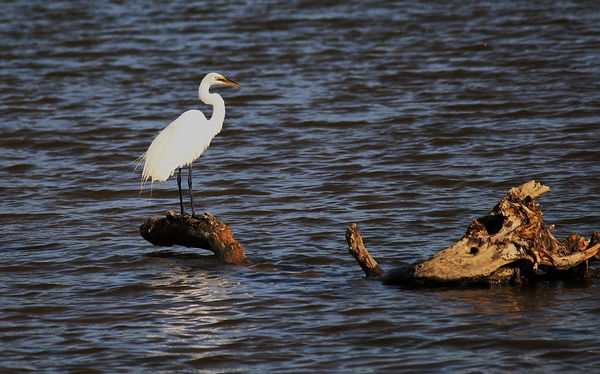
original
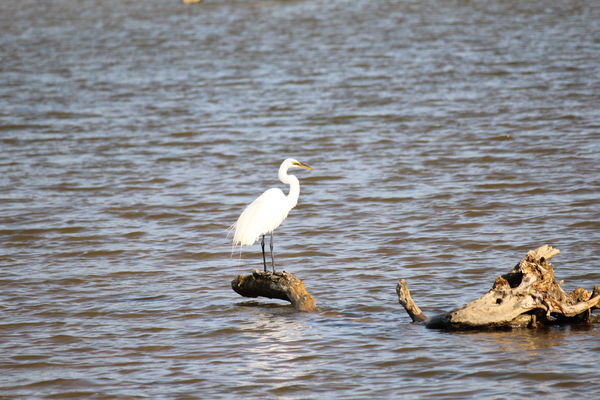
May 18, 2012 09:08:18 #
Use single point exposure metering on the bird to set your exposure for the photo this will improve your photos
May 18, 2012 09:09:10 #
For starters I use ISO 100 on bright sunny days. This helps reduce my chances of "blowing out" the highlights. Then, try this trick. Point your camera at the blue sky, (NOT THE SUN) and use your AEL (Automatic Exposure Lock) button. Lock in your exposure. Turn and shoot your subject. The Blue sky acts much like and 18% Gray Card. This works most of the time. The other thing you might consider doing is changing your metering mode in your camera to the Spot Metering Selection. Last resort...check your histogram and make sure you have not slammed your exposure up against the right side.
I hope this helps
I hope this helps
May 18, 2012 09:26:45 #
May 19, 2012 02:10:47 #
Great egrets can be tough! I use a hand held spot meter most of the time when shooting them. If you do not have one use spot focus and spot metering on your camera, and as was suggested, watch your histogram. Also, set your ISO to 100 instead of 400.
I know everyone says to focus on the eyes but this is one time you might try to focus on the shoulder, it seems to be the area on great egrets that reflect the most light.
One last thought, shoot in raw. You will have more control over your exposure in post processing.
I just realized you are shooting with a T3i. In the menu you can set the highlight alert to enable. This will cause any area that is over exposed to blink when you review your photo. To obtain more detail in those areas you can set your exposure compensation to a negative amount.
This still has some blown highlights but is a little better. You can do a lot in PP sometimes.
Jim D
I know everyone says to focus on the eyes but this is one time you might try to focus on the shoulder, it seems to be the area on great egrets that reflect the most light.
One last thought, shoot in raw. You will have more control over your exposure in post processing.
I just realized you are shooting with a T3i. In the menu you can set the highlight alert to enable. This will cause any area that is over exposed to blink when you review your photo. To obtain more detail in those areas you can set your exposure compensation to a negative amount.
This still has some blown highlights but is a little better. You can do a lot in PP sometimes.
Jim D
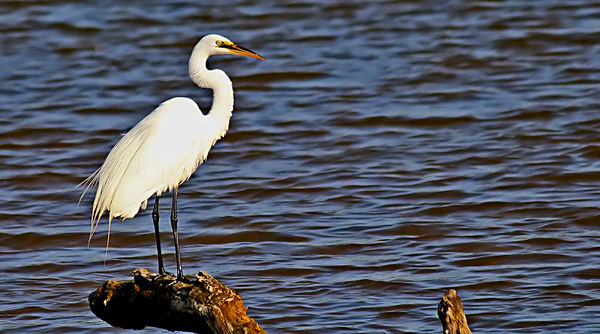
May 19, 2012 02:26:39 #
ronjay wrote:
Recently trying to shoot white egrets on water. Having problems with overexposure. I am using a circular polarizer but does'nt seem to help. Should i try i nd filter or need sugestions. shooting at f/8---1/500 sec--400 iso. Here is the original and a pp shots. the majority of my shoot seem to be out of focus whil sooting in the bright light. thanks
The problem is your meter is averaging. The water is dark, and, as it is the predominant feature, the meter is adjusting exposure for the water. The Egret is simply blown out in the process.
When shooting detailed whites like egrets against the water, you can use exposure compensation to correct the meter's mistake. Go minus a stop or so. Check your Histogram. The whites should not be pegged off the top of the scale.
The second problem is you cannot adjust a digital image where the whites are fully blown out. Had you shot color negative film, there would be no problem. Because it is digital, the issue of blowing out whites to cause full absence of detail is in effect. It is EASY to lighten a too dark image in digital, because all the information is there to manipulate. Blowing out whites is irretrievable.
If you use a spot meter on the egret, the egret will become too grey, as the meter thinks in terms of 18% grey.
Richard Brown
May 19, 2012 05:38:23 #
I use spot metering for 99% of all my bird photography. I use a Nikon D7000 and usually even have the exposure compensation turned down -.3 to 1 full stop, the brighter it is the lower the exposure compensation, and I Only shoot in Jpeg. They come out great. Check out my back post and see for yourself.
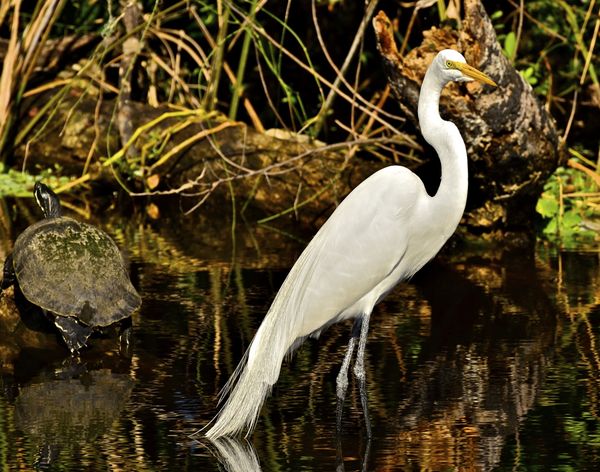
May 19, 2012 06:31:26 #
fstop22 wrote:
I use spot metering for 99% of all my bird photography. I use a Nikon D7000 and usually even have the exposure compensation turned down -.3 to 1 full stop, the brighter it is the lower the exposure compensation, and I Only shoot in Jpeg. They come out great. Check out my back post and see for yourself.
Fstop22 - would your technique apply to an egret in the distance? I shoot them a lot, but they are never as close as yours.
May 19, 2012 06:36:54 #
Yes, you have to meter off the bird for this to work, even at a distance. Go back and check your files and see if you white birds look blown out
nat wrote:
Fstop22 - would your technique apply to an egret in the distance? I shoot them a lot, but they are never as close as yours.
fstop22 wrote:
I use spot metering for 99% of all my bird photography. I use a Nikon D7000 and usually even have the exposure compensation turned down -.3 to 1 full stop, the brighter it is the lower the exposure compensation, and I Only shoot in Jpeg. They come out great. Check out my back post and see for yourself.
Fstop22 - would your technique apply to an egret in the distance? I shoot them a lot, but they are never as close as yours.
May 19, 2012 08:15:57 #
May 19, 2012 08:48:10 #
PhotoArtsLA wrote:
The second problem is you cannot adjust a digital ... (show quote)
Please correct me if I am wrong here. Yes, a spot meter is going to look at a true white as an 18% gray. You are right, this would cause a white that would normally be blown to show a little grayer.
From everything I have read lately the metering system inside a digital camera treats the same white as a 12% to 14% gray This is going to allow the cameras system to be whiter, brighter and more easily blown.
The statement "It is EASY to lighten a too dark image in digital, because all the information is there to manipulate. Blowing out whites is irretrievable. " is also true to the most part.
Now, here is where I may be wrong. It is going to be easier or possible to recover more detail from the gray white tones where as, in the blown white tones you will not be able to recover those details. So I would rather have a slightly gray white tone than a blown white tone to work with. This is why it is normally recommended to move the exposure to the negative side to try and prevent blown whites.
Jim D
May 19, 2012 08:58:39 #
My 2 cents worth, again use spot metering on birds as you can't recover blown out areas. Worse case, adjust white balance if you think bird comes out too grey. Here's another example of metering off white bird, and I Don't adjust the color.
oldtool2 wrote:
quote=PhotoArtsLA The second problem is you canno... (show quote)
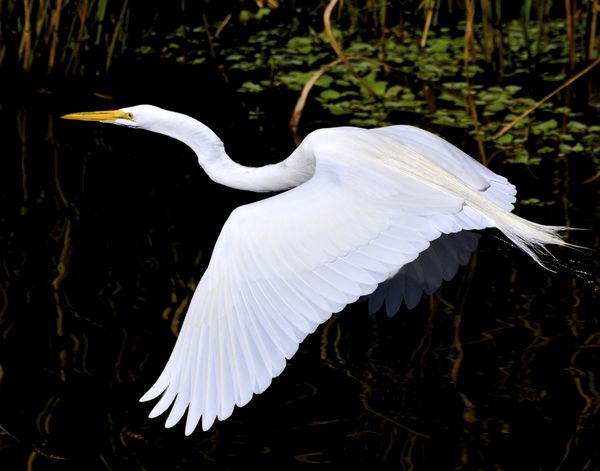
May 19, 2012 09:13:22 #
fstop22 wrote:
My 2 cents worth, again use spot metering on birds... (show quote)
What about shutter speed? I have found I get better feather detail-and less blow-out- on a white bird by using a higher shutter speed, even if the bird is relatively still. Does that make sense? Still learning.
May 19, 2012 09:32:22 #
nat wrote:
quote=fstop22 My 2 cents worth, again use spot me... (show quote)
Yes. If you are shooting in manual, set your exposure to what the camera says is right. As you increase your shutter speed watch your exposure meter. If it moves to the left, the negative side, you are underexposing. Basically just another way of doing it.
Jim D
May 19, 2012 10:22:09 #
sjbegres
Loc: Pittsburgh, PA
oldtool2 wrote:
Great egrets can be tough! I use a hand held spot... (show quote)
Great PP, Jim. What tools did you use?
If you want to reply, then register here. Registration is free and your account is created instantly, so you can post right away.






